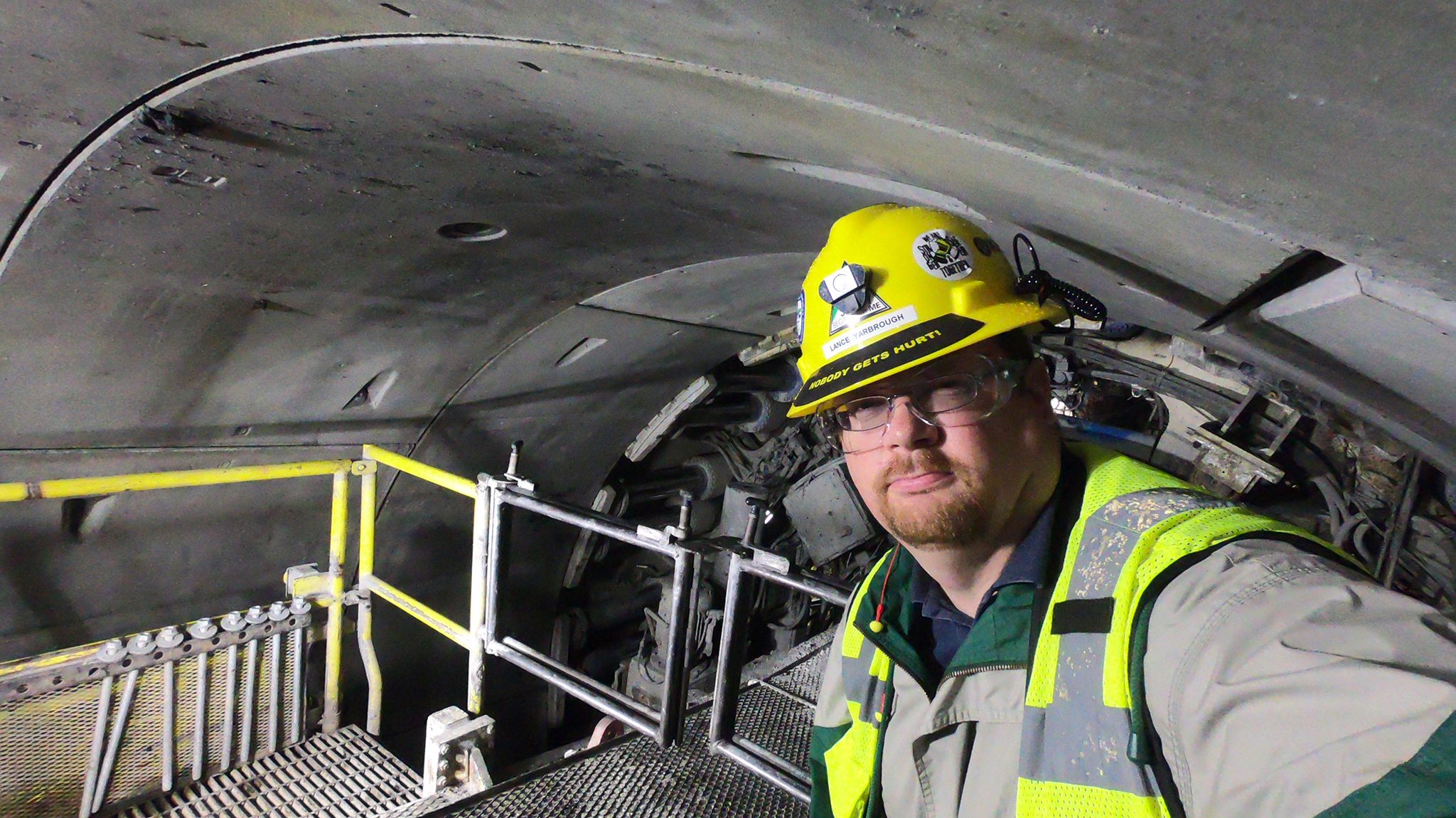
More than 600 feet underground, UM engineering professor Lance Yarbrough stands in front of the articulation thrusters of ‘Nora,’ a 2.7-million-pound tunnel boring machine. The thrusters exert several million pounds of force to push the machine forward to cut into the rock face. Submitted photo
OXFORD, Miss. – For five weeks straight, Lance Yarbrough spent most of his days at the end of a tunnel 600 feet below the Hudson River.
The assistant professor of geology and geological engineering at the University of Mississippi was watching “Nora” – a 470-foot-long, 2.7-million-pound tunnel boring machine – mine through rock 900 feet beneath the Earth’s surface as part of the Delaware Aqueduct Bypass project. The machine operated for 20 months, six days a week, 24 hours a day.
For Yarbrough, being involved in the project was an experience of a lifetime.
“I observed the daily operations of this $1 billion tunnel project, the largest fix ever done to the largest water supply system in the nation,” he said.
Yarbrough was a faculty scholar with Kiewit Underground, the construction company working on the Delaware Aqueduct Bypass.
“Most of my time underground, I was at the end of the tunnel with more than 300 pounds per square inch of pressure acting on the shield of the machine,” he said.
Kiewit began running Nora in January 2018 to build a 2.5-mile-long tunnel to bypass a leaking portion of the Delaware Aqueduct, which provides about 50 percent of the fresh water for New York City.
The machine finished mining the tunnel in late August. The tunnel will be lined with steel and a second layer of concrete now that mining is complete.
At slightly more than 85 miles, the Delaware Aqueduct is the longest continuous tunnel in the world. Originally built between 1933 and 1941, the underground aqueduct is about 20 feet in diameter and carries water from the Rondout Reservoir in the Catskill Mountains of southern New York across the Hudson River Valley to New York City. The aqueduct reaches depths of 1,200 feet in some places.
“My day at the work site would require me to take a man cage down a 900-foot-deep shaft to the tunnel being mined by the tunnel burrowing machine,” Yarbrough said.
Kiewit has been recruiting from the Ole Miss School of Engineering for the past two years, so Yarbrough asked about faculty opportunities with the company.
As a faculty scholar for the underground district and the foundations district, Yarbrough’s overall objective was to take what he learned while embedded with the project team and create training and educational content for use at Kiewit University in Omaha, Nebraska, as well as his courses at Ole Miss and other engineering programs around the world through the Kiewit University Faculty Portal.
Among his daily tasks were quality control and observing tunnel ring segment placement, grouting and mining operations.
“I had a unique opportunity to observe the interactions of project design and construction in a challenging geologic setting,” he said. “I gained a deeper understanding of the interactions between craft worker and the engineering/management of (a) large construction project.”
Yarbrough received access to all relevant files and documents in the project SharePoint, which enabled him to trace decisions made at planning stages through to implementation of the project. This knowledge should prove beneficial to his students, he said.
“It was fascinating to view entire geotechnical reports and testing data to compare with materials mined,” Yarbrough said. “I was able to construct detailed case studies for use in my courses, particularly my drilling technology and ground improvement course.
“Students will have authentic data and learn about the outcomes of engineering decisions made on a daily basis and how those decisions impact the schedule and revenue of the project.”
Yarbrough was a valuable asset both underground at the bypass and aboveground at company headquarters, said Matt Roberts, senior business line manager for Kiewit Foundations Co.
“Lance fulfilled separate rotations with our tunnel group at the Rondout project and with our Kiewit Foundations Co., performing various estimating assignments,” Roberts said. “In both cases, he exceeded my expectations as a faculty adviser.”
Roberts remembers Yarbrough’s first week at Rondout.
“I visited the job to help get him indoctrinated on his first or second day, and he was all ready to go,” he said. “It’s pretty impressive work, and I could tell he was going to enjoy his time there.”
The project began because the decades-old aqueduct is leaking between 15 million and 35 million gallons of the fresh water it pulls from four Catskill-area reservoirs – Cannonsville, Neversink, Pepacton and Rondout – to the city.
As part of the project, New York City agreed to pay for new water systems in a number of affected communities. Wappingers Falls got $11 million for a two-phase project. The first phase ran a water main to New York City’s construction site. The second phase runs a series of distribution mains through the hamlet of Chelsea.
The project began in 2014 with blasting in the Wappingers Falls area. Tunneling began in late 2017. The bypass, which will allow leaking portions of the aqueduct to be taken out of service, reached the halfway point in November 2018.
With the tunnel complete and lined with concrete, four more years of work remain to complete the steel liner and make connections to the aqueduct to bypass the leaking section. The project is on schedule to be complete in 2023.
Yarbrough said he does not plan to return to the project during its final stages, but his work during the summer will enhance his course offerings in the UM Department of Geology and Geological Engineering and greatly benefit students’ education.
